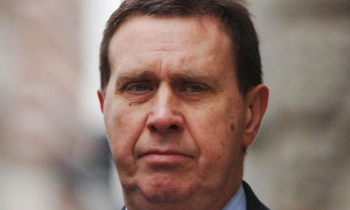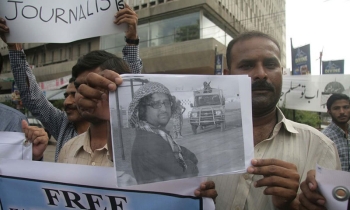During the first half of the century just ended, criticism of journalism was relatively simple and well-defined. It meant taking on the newspapers, which in those days presented a fat, inviting target, burdened as many of them were with sensationalism and sacred cows. Will Irwin muckraked the newspaper press as early as 1911. Upton Sinclair used an artifact of prostitution, The Brass Check, as the title for his 1920 exposé of press malpractice. That same year Walter Lippmann's Liberty and the News deplored the corruptibility of the press in wartime. Silas Bent took on the tabloids in Ballyhoo (1927). And in a series of books in the 1930s George Seldes defended the working stiffs against those he called the "Lords of the Press."
Later, the fondly remembered A.J. Liebling, conductor of "The Wayward Press" in The New Yorker, ridiculed the self-satisfaction of publishers and editorial writers. Yet Liebling, like most of his peers except the grandiloquent Sinclair, never exaggerated his own effectiveness: "I had the impression of machine-gunning the newspapers' armor of smugness with dried beans as ammunition."
In the years since Liebling, journalism has expanded into television, cable and the Internet. It has added new subject matter and formats, and has itself become a subdivision of a vast enterprise known as the communications or information industry. But critics and avenues of criticism have also grown. When the Columbia Journalism Review was started nearly forty years ago, the magazine was almost alone in providing a vehicle for continuing press criticism. Now CJR shares the work with a great variety of competing or complementary efforts -- other surviving journalism reviews, reporters and reviewers assigned to media beats, on-air critiques, online spinoffs and startups, causist organizations right and left, the still-flourishing alternative press, professional associations, a few state and local press councils, scholars, and intellectuals in journalism schools and elsewhere, such foundations as the Freedom Forum, and -- wonder of wonders -- media criticism's nearest approach to a mass-market magazine (now part of its own conglomerate), Brill's Content.
The scale of this enterprise was reflected in a recent Lycos Internet search that turned up nearly 74,000 references to the term "media critic." Not all media criticism, however, is equally worthy; much of it is mere chatter. To help sort out at least part of the much-altered critical landscape, CJR has assigned writers to appraise major segments of the enterprise, including CJR itself, and their reports appear on pages 36-51.
The most obvious conclusion to be drawn from these reports is that open discussion of media (and journalism) issues is now taken for granted. Only a few decades ago, the organized press regarded criticism from outside as irrelevant and from inside as disloyal. In forty years, media managers may not have learned to love criticism but they have grown used to bearing it. For example, the refusal of news organizations to discuss the troubles of other news organizations has long since gone by the board. The grief that the Los Angeles Times brought on itself with its ill-advised Staples deal was chewed over in the press, in the critical magazines, on the air, and on line -- and, ultimately, in the Times itself.
More important, the conclusion by mainstream media that the media themselves are an important news subject means that journalists are no longer the only audience for information about the media. This is appropriate, given the growing visibility and influence of the media in American society. The more the public knows of how the media operate, the more intelligent (even if a bit more cynical) will be its responses to what the media have to offer.
If anything has been lost along the way, it is the stimulation of a challenging and well-written literature of criticism. Liebling still has faithful readers in and out of journalism, and he had worthy successors in, for example, Ben Bagdikian, who has been warning of the danger of media monopolies for more than thirty years; and Fred W. Friendly, who became a guru of press ethics. Nor is there a publication that matches the amusing contrariness of [More], the old New York journalism review featuring David Halberstam and J. Anthony Lukas, which in the end suffered the ignominy of merger with CJR.
But it is difficult to find in today's array figures of comparable distinction. Instead, the best-known practitioners are such durable reporters as David Shaw of the Los Angeles Times and Howard Kurtz of The Washington Post, who are outstandingly competent but specialists, not advocates.
The old criticism had a reformist bent: Sinclair and Liebling both thought endowed newspapers might help. Neo-traditionalists such as the Project for Excellence in Journalism (supported by the Pew Charitable Trusts) call for a return to professional standards. Although there has been interest in a change-oriented program such as public journalism, today's critics tend to accept the structure of the media as a given. To find serious discussion of the role journalism plays in society and the polity, it is often necessary to turn to such scholars as Michael Schudson, James W. Carey, and their peers.
For journalists, the ultimate question is whether this growing stream of criticism helps them to do their work better -- that is, to be both more skilled and more responsible. The answer is mixed. Without doubt, critics have helped raise the consciousness, or self-consciousness, of journalists. A Pew Research Center poll in 1999 showed majorities of the journalists polled agreeing with such broad criticisms of the media as their failure to cover complex issues or to distinguish clearly between reporting and commentary.
Yet it is less clear that working journalists find media criticism specifically relevant to their own conduct, or that the vehicles of media criticism are paying sufficient attention to those who work in the subbasements of the industry that Liebling presciently compared to a "gigantic, super-modern fish cannery." Critics and media reporters concentrate too often on petty violations, such as ephemeral conflicts of interest, when journalists may need help on truly substantive issues, such as what to do when faced with the eternal conflict between organizational policy and individual conscience. Even in an age flooded with media criticism, critics need to find more effective ways of addressing the working press.









